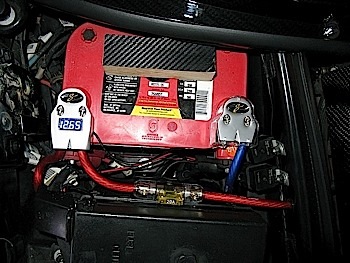One test is not enough if you are diagnosing a charging system problem. All too often, the alternator is condemned as the source of the problem if only battery voltage is present with the engine running. If this is the case, it only means that the alternator is not charging, but does not reveal why.
For some alternators, it’s normal to see as low as 13 volts. For some, a constant 13.6 volts is an indication of a problem. For others, it’s normal to see as high as 16 volts for long stretches. Still, it’s perfectly normal for others to see the alternator not charge at all intermittently.

This wide discrepancy in voltages is due to the fact most alternators are controlled by the ECM or PCM to improve fuel economy. This means that load on the engine is controlled to reduce parasitic loss at the crankshaft. Alternator output is on demand when there are loads detected or the battery needs to be charged.
Depending on ambient temperature, charging voltage varies. The actual charging voltage designed into a voltage regulator is dependent upon factors such as how far the alternator is located from the battery and the ambient air temperature surrounding the battery as calculated by the PCM. This is why the ambient and underhood temperatures are critical data for the charging system.
Another factor determining battery voltages are automatic transmissions with five or six speeds that can drastically reduce engine speed when cruising. Many modern engines operate well under 2,000 rpm until they reach highway speeds of about 60 to 70 mph. Consequently, if the alternator doesn’t maintain rated charging voltage at lower engine speeds, the battery will discharge under heavy accessory loads. In most cases of undercharging, the alternator may have an incorrect diameter pulley installed, the drive belt may be slipping or the alternator itself might be under capacity for the vehicle application.

Although load-testing an alternator provides a quick way to test for drive belt slippage, keep in mind that an alternator can easily be overheated when testing for maximum output during low-speed operation for an extended period. Most alternators will not be able to keep up with the load when idling, and the lack of cooling compounds the problem even further. Some systems might even stop charging if an extreme load is detected and set a code.
Not knowing what controls what, and how it is supposed to function, can cause a misdiagnosis. This might also cause you to overlook critical problems. Take time to look at the service information.
The other critical tool to effectively diagnose an alternator is a scan tool. On older vehicles, the battery light would turn on the alternator light when the alternator output or battery voltage dropped below a preset value. The battery light on modern vehicles, however, is controlled by data and trouble codes. This is why a scan tool is essential to diagnosing a charging system. These codes can lead to a faster and more accurate diagnosis. Codes for the alternator can be found in the engine control module and the modules that control the distribution of power to the vehicle. Also, most modules on a vehicle will set a code if low system voltage is detected.
Testing the Battery
The rule of thumb that states 12.6 volts equals a fully charged battery and 12.2 volts means it is 25 percent charged, is starting to change with some modern batteries and charging systems.
If there is a dead or weak cell, normal charging voltage can’t be achieved on a battery with a bad cell. The alternator will overcharge the remaining cells and boil the electrolyte in the other cells. At the other extreme, a battery that is sulfated due to being undercharged or not seeing constant use will maintain normal charging voltages. The symptoms of a sulfated battery are that it charges very quickly and produces a very low amperage discharge rate.
Fewer and fewer batteries allow the technician to view electrolyte levels or test individual cells. This is why testing with an electronic conductance tester that measures cold cranking amps is the most accurate way to assess the condition of the battery.
Because new batteries typically test as much as 25 percent higher than their rated capacities, a recently replaced battery with a bad cell can occasionally pass both a conductance and a load test.
Parasitic Draws

As a rule, the key-off current drain on most late-model vehicles should be less than 50 milliamps (mA). If a draw is depleting a battery, it can mean extra stress on the alternator and charging system. But on some vehicles, it might be normal to have even greater draws for up to 10 minutes after the keys have been removed from the ignition.
During this period, the serial data buses could be communicating and performing some digital housekeeping. Also, systems like air ride, evaporative emissions systems and auxiliary water pumps could still be active long after the vehicle has been parked. This is why in some service information for modern vehicles, an OBDII breakout box and a scan tool are necessary to solve some intermittent parasitic power drains.
Check The Pulley
Many late-model vehicles use a decoupler pulley on the alternator. These new pulleys allow the alternator to “free-wheel” or “overrun” when the belt suddenly slows down. This prevents the belt from slipping and reduces vibration. Best of all, in this scenario, the system needs less tension and a narrower belt can be used. This can result in a 1.5 to 2 percent fuel economy improvement. However, these pulleys have a limited lifespan due to how they operate internally.
Some replacement alternators will not come with a pulley or a solid pulley. If the replacement alternator does not come with a new pulley, be sure to install the correct pulley with it. If not, the replacement alternator can fail sooner than expected.
If you don’t see the recommended voltage when you check charging voltage at the battery with the engine idling, check the wiring connections at the alternator—not just visually or by wiggling the wires or connectors, but checking for excessive resistance by doing a voltage drop test. Many so-called alternator problems turn out to be nothing more than a bad connection at the alternator or a bad wiring harness.
Avoid This Bad Practice
If you see a modern vehicle that measures the life or temperature of the battery, it is bad practice to use the positive and negative battery terminals to power aftermarket accessories. The extra connections can cause the battery to incorrectly report the state of discharge, despite a normal battery condition. This can cause overcharging and/or codes to be set that may cause the charging light on the instrument cluster to illuminate.














